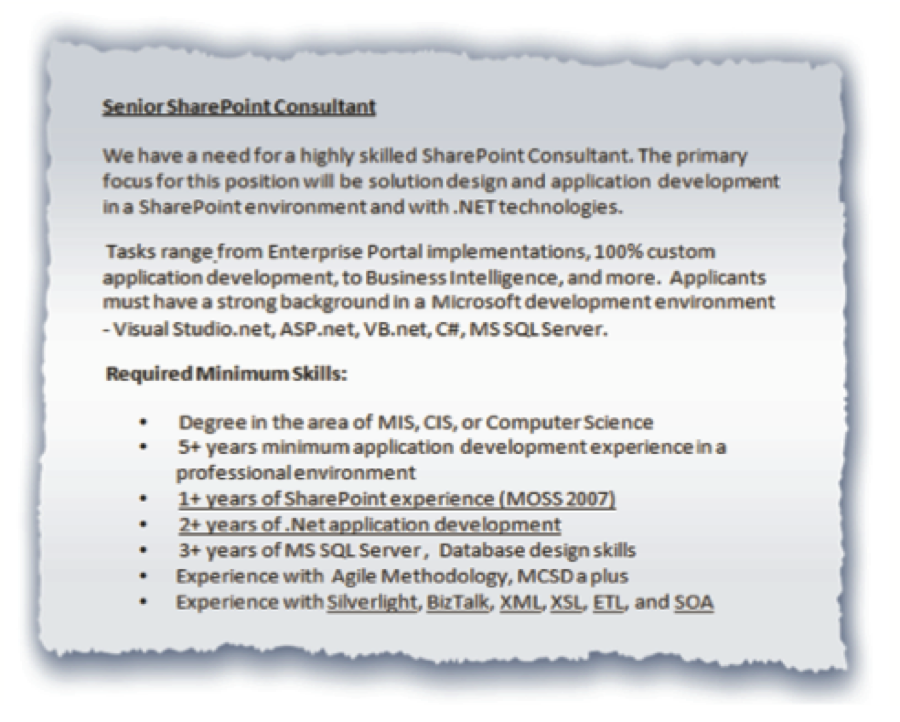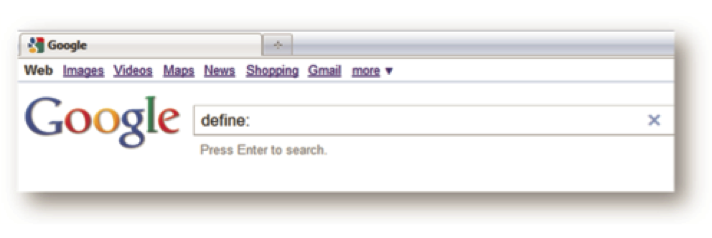Kerri, a senior technical recruiter with eleven years’ experience, has noticed that slowly but surely the requirements for the regular .NET developer and database developer positions are requiring more and different skills than she has been used to. She is finding that she does need to learn about these new tools but knows from experience that it takes a lot of her time to research. “I need information on how to validate these skills, to know if the candidates really have the skills or not,” says Kerri during a training session.
The usual research practice to learn about these skills starts with wiki search, the purchase of one or two software development beginner books (written for the developer audience), and ends with joining a number of developer user groups, only to find out that these practices are not effective and not really helping with screening. For one, the books are full of jargon and require prerequisite knowledge in technology. Second, how do online groups really help one in validating skills?
She loathes the idea of asking her client, and does not want to ask her candidates for fear of appearing ignorant of such well-known technologies. Kerri knows that to continue to be successful in her career, she needs to stay on top of her game. And this game includes learning all she needs to learn (as much as is relevant to her job) in IT to be able to successfully screen candidates and match them to her clients.
I have met many other recruiters like Kerri who want to learn how to screen and validate technical skills in order to ask the questions that make the matching process faster and more effective.
As targeted as technical screening is for recruiters, it also benefits hiring managers and candidates.
For the Hiring Manager — Technical screening done right reduces the amount of time the hiring manager spends in the screening process and makes the recruiting process a little easier. It informs the hiring manager of the recruiter’s abilities and that the recruiter is skilled in the art of screening and only sends candidates that not only match the requirements but who will fit their environment, a big differentiator in today’s recruiting market.
For the Candidate — No candidate wants to spend time going for an interview where they have a diminutive chance of being hired. When a technical recruiter performs a really-get-to-know-you technical screen (not interrogation) to find out about the candidate’s skills and abilities, the candidate feels that the recruiter is an ally who will protect his interest and represent him well to the hiring manager. This translates to a healthy candidate-to-recruiter relationship that results in referrals: a win situation for the recruiter.
For the Recruiter — The better fine-tuned the technical screening process is, the more efficient the recruiters are at matching candidates’ skills and experience to their clients. It saves time—there’s no sense reviewing, scheduling, and doing all the work involved in sending four candidates for interviews when one candidate could suffice.
It is possible to avoid the unnecessary cycles of presenting several candidates for interview who are rejected either because the job description was misunderstood or the candidate screening process was ineffective, or a combination of both.
During a training session with technical recruiters, we reviewed a job description that was posted on the recruiters’ company website. It was for a C# Developer. The job description was seeking a mid-level developer with 1-2 years development (C#, ASP.NET, SQL Server, and Web Services) and analytical experience, who also had experience in SQL Server Reporting Services (SSRS) and SQL Server Integration Services (SSIS).
On reviewing the job description, I saw bright red flags and proceeded to explain. First, the notion that a mid-level developer would have 1-2 years experience is not entirely correct. Mid-level experience is closer to 4-6 years. The second flag is the requirement for the mid-level C# developer to have experience in SSRS and SSIS. It is very possible for a mid- level C# developer to have experience in SQL Server, but not to the extent of having experience in SSRS and SSIS. These are tools used by SQL Server Developers and Data Analysts and not necessarily C# Developers. Another flag was the term ‘Analytic’ found near the terms SSRS and SSIS, which points to the fact that this position was mismatched. I went further to say that what the hiring manager was most likely looking for was a SQL Server Developer with C# development experience and not a C# developer.
No sooner had I finished that sentence than a recruiter in the session raised his hand to inform me that not only was he privy to that particular job description but that the candidates sent to interview with the hiring manager were rejected. The hiring manager then later informed the recruiter that the requirements and title of the position were to be changed to SQL Server Developer instead of C# Developer. The hiring manager had found out during the interviews that their need was for a SQL Developer instead.
These are recruiting and interviewing cycles that could have been avoided had the recruiter understood the job description and advised the hiring manager accordingly.
As demonstrated from my personal anecdote, technical recruiters should understand the technologies in which they recruit, how they are used, and the importance to the hiring manager. While there are many ideas out there that are geared toward acquiring this knowledge, here are a few strategies that can be implemented in a typical day for a technical recruiter. These strategies, when put together, help ensure that the matching and recruiting process is accomplished in fewer cycles than it usually takes.
Technical screening involves three steps:
- Evaluate the Job Description
- Review the Resume
- Form Questions
 If there is one hour allotted to the review of a technical job description, building of screening questions, and matching candidate resumes, then this time can be divided with the job description review taking over 50% of the time, resume review with 30%, and questions forming and match finding taking the rest of the 20%.The job description review is where it all starts to either come together or fall apart.
If there is one hour allotted to the review of a technical job description, building of screening questions, and matching candidate resumes, then this time can be divided with the job description review taking over 50% of the time, resume review with 30%, and questions forming and match finding taking the rest of the 20%.The job description review is where it all starts to either come together or fall apart.
The job description review is the first and most important aspect of making a match. Once the job description is thoroughly understood, every other process becomes easier. To follow these steps, we look at a real-life job description of a SharePoint Developer.

Evaluating the Job Description
The first thing to do is to ensure that all the skill sets and technical terms are understood, i.e. what they mean and how they are used in the context of the job. The second is finding and answering all the questions that arise from the job description. These are questions that candidates may ask, for which answers must be given.
Understand all the technical terms. If there are skill sets in the job description that are not understood, it’s all too easy to ignore them. The best practice is to find information on the skills. This can be achieved by either a combination or either of two means: (a) Google—this is the quick and simple fix, or (b) RSS (Really Simple Syndication)—this is like the continuing education: requires time but well worth it.
- Using Google: Go to Google, type the word ‘Define’ and a colon then type the word you seek to understand, and hit the enter button. For instance: ‘define:ETL’. This will list a variety of definitions of the word and how the word is used. This is a quick and easy way to build your technical vocabulary.

- Using RSS: You can add an RSS feed for a particular technology or topic as a subscription in Microsoft Outlook (2007).This gives you broad insight of aggregated content from multiple sources in one place so you don’t have to go to numerous websites to find the information you want. For example, if you are looking to find more information on “SAP Customer Relationship Management CRM,” the link is http://www.crmexpertonline.com. Search this web page for the RSS icon. When found, click on the RSS feed link, which displays a page that allows you to subscribe to the content on that page. This is a more detailed and in-depth way to build your technical vocabulary.
Finding and answering the questions in the job description. Every written document elicits questions, no matter how well written. A good practice to develop is to always read job descriptions with an inquisitive attitude—are there any mis-matched skills, why does the hiring manager need this skill, how many people are in this team? The questions may differ depending on the prerequisite knowledge of the reader. In this particular job description we notice a few.
- How is it that this job description is looking for a senior person but the main skill set requirement for that position—SharePoint—is 2+ years experience? There is incongruence here. Candidates with senior experience usually have 8-10 years experience.
- Why is the title listed as consultant when this is clearly a developer role? Would this job description be better served if it says SharePoint Developer (.NET)?
These questions should be directed to the hiring manager for answers. Once the questions are answered, it increases the understanding of the job, which helps when describing the position to potential candidates. The answers can also be used to update the job description to attract the right kinds of applicants. In this case the job description title may change from Senior SharePoint Consultant to SharePoint Developer (.NET).
Aside from finding and answering questions in this job description, relevant knowledge can be acquired from this exercise. From the job description we know that:
- This is a Microsoft Windows environment
- The main job role is for web development in a Share- Point platform using .NET tools
- The methodology used in this environment is Agile
Reviewing the Resume
Now let’s look at a sample SharePoint Developer’s resume to review and find additional questions that can be used for screening.

Aside from matching the technical skills of the requirements with that of the candidate, there are other aspects of the position and its technical environment that affect the compatibility of a candidate to a job. These are the pace of development/work, the project team makeup, and type of organization.
Looking at the resume and the job description, one could immediately say that the candidate would fit this position like a glove fits a hand. But before jumping to any conclusions, look at all the facts of this job, its environment, and the resume to actually see if this is a good position for the candidate and vice versa.
Using a sample suitability matrix, if the hiring manager and candidate have as much disparity as is shown on the matrix below, it becomes clear that the candidate and hiring company may not be a good match.
| QUESTION | HIRING MANAGER | CANDIDATE |
| Type of company | Fast-growing IT company with web-based products. | Traditional company where learning and teaching others is encouraged. |
| Average week/pace | 55+ hrs per week, sometimes more. | 40 hrs per week, with plus or minus two hrs. |
| Prop cycle | Twice a week, with one or two hot fixes per week. | Once a month; on some occasions twice a month. Hot fixes are inevitable, but are at a minimum. |
| Suitability Matrix |
Forming Screening Questions
At this point screening questions should be building up from reviewing the job description and resume. What can we find out about this candidate that will be attractive to the hiring manager? What makes this candidate tick? Ensure that the preliminary greetings have been performed and that the candidate understands why the recruiter is calling. Here’s a sample segue from introductions to specifics.
“I’m going to ask you some general questions; your answers will give me a better understanding of what you do and perhaps what you enjoy the most in your job as a SharePoint Developer. Is that all right?”
Specific Job Description Questions
Looking at the job description and resume, here are some specific questions that you could start asking today.
Background
- What is the makeup of your development, testing, and production environments?
- How many servers do you have in each environment?
- What development process do you follow at your current company?
- How many other people are/were in your team? What are/were their roles?
Specific to Job Description
- How did you start your career in SharePoint development?
- Am I correct to say you have about five (interject the years of experience) years’ experience in SharePoint Development?
- Think of one project—what would you say were the benefits of using one methodology over another for this project?
- What were the business considerations you made for some of the SharePoint development work you did?
Specific to Resume
- Tell me about the MOSS and .NET based Enterprise Content Management System—what problem did this solve?
- How long was the project?
- As a lead person, what would you have done differently to shorten the project time?
The great thing about these questions is that the answers can be used by the recruiter to present candidate profiles to hiring managers. The answers also give the recruiter verbiage that can be used when describing the candidate to the hiring manager. The most important of all the advantages of this screening process is that the recruiter is able to recognize (with supported information), if the candidate has the characteristics listed in the job description.
Using the tips outlined above, you see that the screening process starts with understanding the intent of the job description. Every minute spent learning more about the job description helps boost a recruiter’s confidence and ability to validate technical candidates for a successful match. When you continue to do this on a regular basis, don’t be surprised when three things start to happen—a) your recruiting services are requested on an ongoing basis, b) your candidates send your team more referrals and c) your team is able to do more in less time.
Main image by George Reyes
